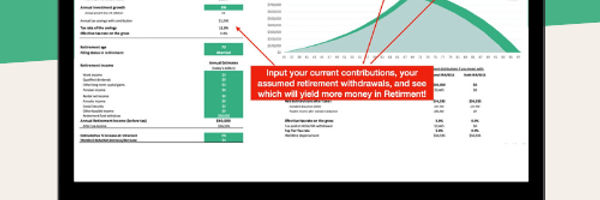Investors that prefer to maintain control over their money have some good news in the form of a self-directed IRA. This is an individual retirement account established with a stockbroker rather than a bank or an investment house.

Roth IRA or 401k? This template will answer your questions.
With this template, you will get:
All DFY, simply add your details
Charts for comparison and clear answer
Easily update for any year (2023, 2024, 2025, etc…)

Advantages of a Self-Directed IRA
With a self-directed IRA, it's possible to buy and sell individual stocks, allowing for greater control over the investments in the account. Management fees don't apply, so these IRAs are more efficient too. Self-directed IRAs are suitable to anyone that wants to have more control over the investment strategy of their retirement funds, and are comfortable with taking on that responsibility.
Starting a Self-Directed IRA
Additional Resources |
Unfortunately, the process of starting one of these funds is more complicated than just pulling the money from an existing account one day and trading stocks with it the next. The IRS wants to make sure that money put aside for retirement is actually used in retirement. So they've established some rules around the transfer of funds between accounts. To start the process of creating a self-directed IRA, the owner needs to make sure the account passes the rules, or tests, the IRS has set up for any IRA. To summarize those requirements:
The trustee or custodian of an IRA must be a bank, a federally insured credit union, a savings and loan association, or an entity approved by the IRS to act as trustee custodian. This list includes a stockbroker's account.
The trustee or custodian agrees not to accept more than the allowable annual contribution limits for an IRA.
All contributions, except for IRA rollovers, must be in cash.
The account must offer a non-forfeitable right to the money in the account at all times.
The money in the account cannot be used to purchase life insurance.
The assets in the account cannot be combined with other investments owned by the accountholder.
Finally, there are minimum required distribution rules that apply to these accounts.
Setting-up a self-directed IRA is not a new process, so an established stockbroker should be able to ensure the new account passes all of these rules.
Setting-Up a Self-Directed IRA
The next step is to contact a broker, asking them to help set up a self-directed IRA. That broker, in turn, will require the applicant to complete two forms. One form is a basic IRA application, which is similar to ones used whenever setting up an IRA account in the past.

The second form is one that needs to be sent to the existing IRA custodian. The IRS uses a system of "custodians" that are charged with taking care of retirement money for individuals. Money must pass from one custodian to the next.
Account Transfers
The second form will direct the custodian of the account to transfer the funds of an existing IRA account into the self-directed IRA at the brokerage house. Brokers will typically send forms immediately, if not overnight. They may even be available for download right from the broker's website. These forms are readily available because a broker is eager to add IRAs to the portfolio they currently manage.
Delays in Setting-up an IRA
After filling out these forms, comes the waiting part of this process. The existing IRA custodian is probably not that eager to have funds transferred to another company. They can't delay this forever, but typically it will take between 30 to 45 days for the transfer to occur. A trustee-to-trustee or custodian-to-custodian direct transfer allows the accountholder to avoid income tax penalties, withholding, or any other IRS requirement - permanent or temporary in nature. These issues are discussed in detail in our article on IRA Rollovers.
About the Author - Self-Directed IRAs



.jpg)
.jpg)